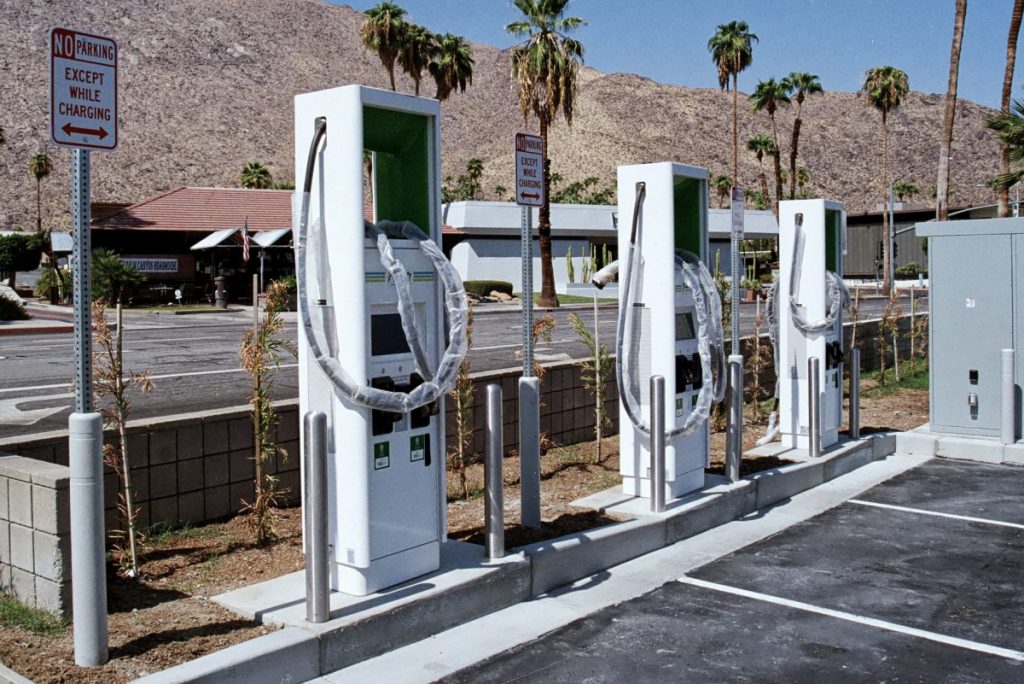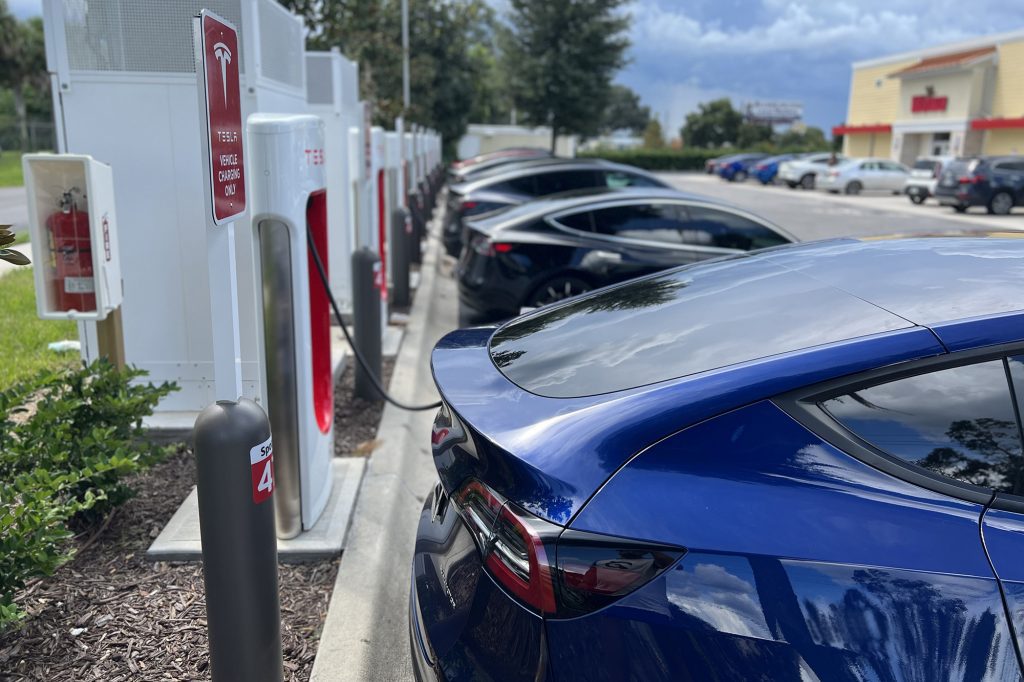Skift Take
Travel industry businesses have an opportunity to shape their destination's long-term future right before electric vehicle adoption takes off.
Destinations and businesses may have an opportunity to grow their tourism economies and brands with electric vehicle drivers. Large sums of newly available federal funding could help them install charging stations at locations that bring visitors — and revenue.
To promote the proliferation of electric car adoption, the Biden Administration and Congress are making billions of dollars available to states and businesses to invest in charging stations.
In February, the Biden Administration made nearly $5 billion available over five years to states to boost electric vehicle infrastructure.
State governments will build a network of charging stations spaced a maximum distance of 50 miles apart along designated corridors. As of September, all 50 states, the District of Columbia and Puerto Rico have been approved for fiscal years 2022 and 2023.
Another Biden program, budged at $2.5 billion, governments, agencies and other entities are eligible to apply for grants to receive funding to build publicly accessible charging stations along designated alternative fuel corridors. At least 50 percent of this funding has been aside for community grant programs where priority is given to projects that expand charging infrastructure within rural areas, low-and moderate-income neighborhoods and communities with a low ratio of private parking space.
Under the discretionary program, communities and private businesses like hotels and attractions can submit bids for grants to help pay for charging stations, which can cost upwards of $100,000, according to Cree Lawson, founder and CEO of Arrivalist, a visitation intelligence company. The program was set to launch on November 15 but has been delayed for an indefinite period of time, he said.

Some destination marketing organizations are working with their state government officials to take advantage of the federal program to support their state’s visitor infrastructure. Visit North Carolina, which expects to receive $109 million over five years, is working with the North Carolina Department of Transportation to identify the Alternative Corridors and where to put the stations, according to Visit North Carolina Director Wit Tuttell. From there, Visit Carolina will build out these areas to provide more transportation options for residents and visitors.
In many states, electric vehicle chargers tend to be scattershot, more focused on local needs and travel and concentrated more in urban areas than rural areas, turning large segments into EV deserts, according to Arrivalist’s Lawson.
North Carolina hopes to make electric vehicle drivers comfortable enough to travel around the state. “We think that’s really going to help to alleviate the fears of anyone and a lot of them to get through most of the corridors in the state with that first phase,” said Visit North Carolina’s Tuttell.
For destinations, charging stations can potentially move their destination and stakeholders further on a more sustainable path toward emissions reduction. Supporting the proliferation of so-called EV charging stations can help the tourism industry cut back on its carbon footprint and other negative impacts.
Electric vehicle tourists will have significant periods of time waiting for their car to charge. During this idle period, they will be more likely to spend money at the location and be enticed to explore the destination.
“You’ve essentially got a captive audience when you have that person recharging. There’s an opportunity there for not just to sell a product,” Visit North Carolina’s Tuttell said. “If that charging station is, say, a local tourism office or a visitor center, it’s an opportunity to showcase different things in the area.”
Stations present opportunities to attract visitation, especially to rural and underserved areas. “It would almost be like passive tourism,” she said. “They needed to charge, they stopped and then they realized what a cute town it was and then they bring their family back,” said Cassandra Harrington, executive director of This Is Cooperstown, the destination marketing organization for Cooperstown, a rural village in New York with multiple charging stations, one of which is at its National Baseball Hall of Fame and Museum.
By placing them at the hotel, restaurants, national parks or attractions, travelers on the road — who otherwise would stop at a gas station — can be lured into the destination because of the available charging stations, according to Matt Berna, president of Intrepid Travel and a longtime owner of an electric car. Wyoming wants to place some of its stations near Yellowstone National Park.
Hotels would be the best place to put them, according to Intrepid Travel’s Berna. Electric car drivers have access to apps, their car’s navigator and other sources of information that show them the available charging stations on their trips. These drivers will go to the hotels with chargers and plug in their vehicle overnight. During their stay, they will spend time and money at the destination, Berna said.
Eco-Friendly Branding for Destinations
The proliferation of charging stations can also contribute to strengthening a destination brand as eco-friendly, especially for international travelers that prefer sustainable options. In fact, Europe and China already lead the U.S. in electric vehicle adoption and sales by millions, according to IEA.
“We understood and, this is a little bit of a longer play, that the international market was really interested in environmentally friendly travel and wanted to continue to position ourselves of the place where you can do that,” said Scott Brickert, interim vice president of Travel Oregon, which has been expanding working with its state government to expand its extensive electric vehicle network since 2017 and now covers hotels, spas and other areas.
The number of electric car owners in the U.S. is pretty small. Only nine percent of Americans own an electric or hybrid vehicle, according to a 2022 Pew Research Center survey. They also tend to be more affluent, which does make them a potentially high-spending tourist.
“I would say that in general up to this point electric vehicle owners have been at a minimum middle middle income, if not upper income,” Brickert said. “But we’re seeing all the different companies come out with vehicles now and those price points are going down especially with rebates available that can be more affordable.” Electric vehicles are also becoming more available on the used car market, he said.
Some large tour groups are waiting to incorporate electric cars into their operations, which electric-friendly destinations could capitalize on. “We’re looking to build an electric vehicle fleet as well for multi-day trips with up to 15 passengers,” Intrepid Travel’s Berna said. The tour operator needs vehicles that handle 200 plus mile trips and carry at least 10 passengers, luggage and provide air conditions. “We’re hopeful we’ll see in the next two to three years a commercial vehicle option,” he said.
There’s no shortage of money to support the electric vehicle adoption movement. Manufacturers plan to spend $1.2 trillion through 2030 to develop and produce electric cars, according to Reuters. Jaguar, Bentley, Cadillac and others plan to produce and sell only electric cars by 2030 while GM will do so by 2035.
Even if visitors don’t own a vehicle, they are becoming more available to rent on their trips. Hertz, for example, plans to convert 25 percent its fleet to electric before 2025.
The Daily Newsletter
Our daily coverage of the global travel industry. Written by editors and analysts from across Skift’s brands.
Tags: climate change, electric cars, road trips, sustainability
Photo credit: Destinations, like this one in California, have an opportunity to get money to support the development of their electric vehicleinfrastructure Flickr / Ron Gilbert


